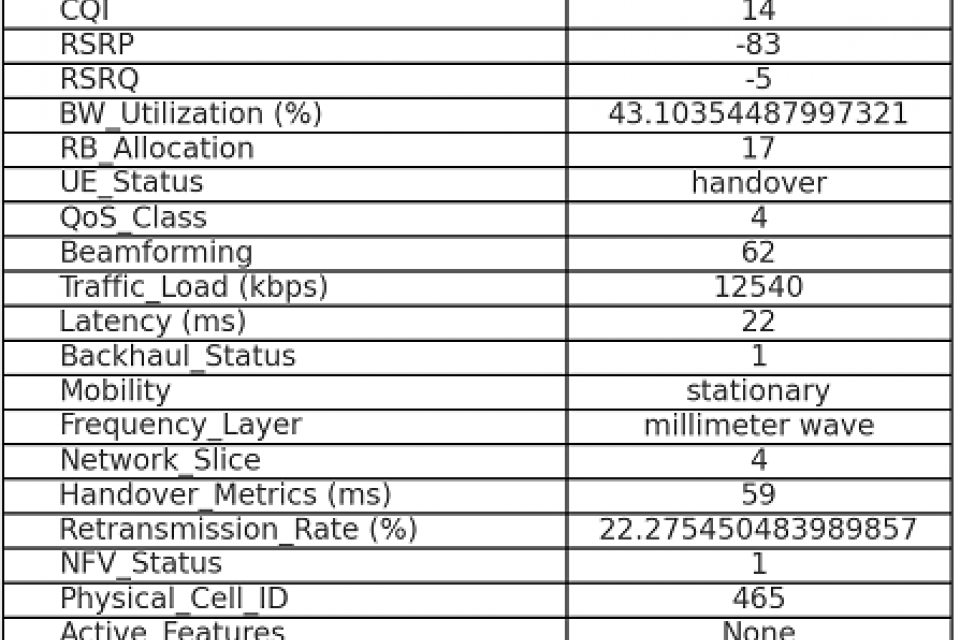Datasets
Standard Dataset
5G-Network-Metrics-for-High-Traffic-Event
- Citation Author(s):
- Submitted by:
- K M Karthick Ra...
- Last updated:
- Fri, 08/18/2023 - 01:49
- DOI:
- 10.21227/1ryt-wb82
- Data Format:
- Links:
- License:
 2404 Views
2404 Views- Categories:
- Keywords:
Abstract
Dataset Description:
Based on some real-world events, the dataset offers a synthetic representation of 5G network states and metrics during a high traffic event, such as a major sports gathering in a city. Each row corresponds to a unique record capturing the attributes of the network at a particular moment, and each column corresponds to a specific feature or attribute.
Significance:
§ Network Monitoring & Analysis: The dataset can be used to monitor the network's performance, identifying areas of strength and potential bottlenecks or issues.
§ Resource Allocation: It can assist in making decisions about resource allocation, ensuring efficient utilization and optimal user experience.
§ Predictive Analysis: The dataset can be used to predict future network states or user demands, helping operators prepare in advance.
§ Network Optimization: The detailed attributes can aid in fine-tuning network configurations for performance, reliability, and efficiency.
§ Event-Driven Network Analysis: This dataset can be pivotal in understanding how a 5G network behaves during high-demand events. It can shed light on the network's adaptability, resilience, and potential pressure points.
§ Capacity Planning: By analyzing the dataset, network operators can anticipate the kind of load their infrastructure might face during similar future events and can plan capacity upgrades accordingly.
§ Service Assurance: The dataset can highlight areas where service quality might degrade during such events, enabling preemptive measures.
§ Traffic Management: Insights from the dataset can guide strategies for traffic shaping, load balancing, and content delivery optimization during high traffic periods.
Nature:
§ Diverse: The dataset covers a wide range of network metrics, from signal strength to user equipment status, providing a holistic view.
§ Multifaceted: It provides both categorical (e.g., UE Connection Status) and numerical (e.g., RSSI) data, offering a comprehensive view of the network.
§ Synthetic: Though the data is artificially generated, it's shaped to emulate real-world behavior during high traffic events and is valuable for simulations, model training, and theoretical analysis.
Beneficial Features:
Comprehensiveness: The dataset encompasses almost all crucial aspects of a 5G network, making it valuable for a multitude of use-cases.
§ Granularity: Features like RSSI, RSRP, and latency provide detailed insights into the network's performance at a granular level.
§ Resource Allocation Metrics: With attributes related to bandwidth utilization, resource block allocation, and current resource allocation, operators can gauge the efficiency of resource utilization.
§ User-Centric Metrics: Features like UE demand and connection status ('UE_Status' column) give insights into user behavior and requirements.
§ Network Health Indicators: Metrics like retransmission rates, channel conditions, and interference levels serve as indicators of the network's overall health and performance.
Event-Centric Metrics: The heightened values in traffic load, bandwidth utilization, and user demand capture the essence of the high traffic event.
This sample record showcases a moment during the high traffic event. The UE is in a handover state, implying mobility. The bandwidth utilization and user demand are relatively high, signifying the increased activity during the event. This snapshot, like others in the dataset, offers insights into the network's performance and status during high-demand scenarios.









